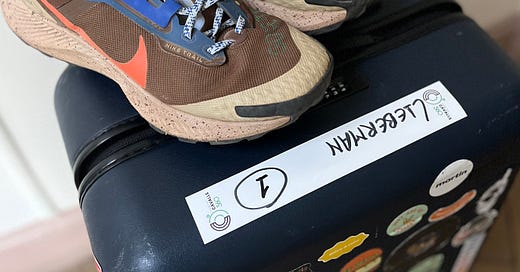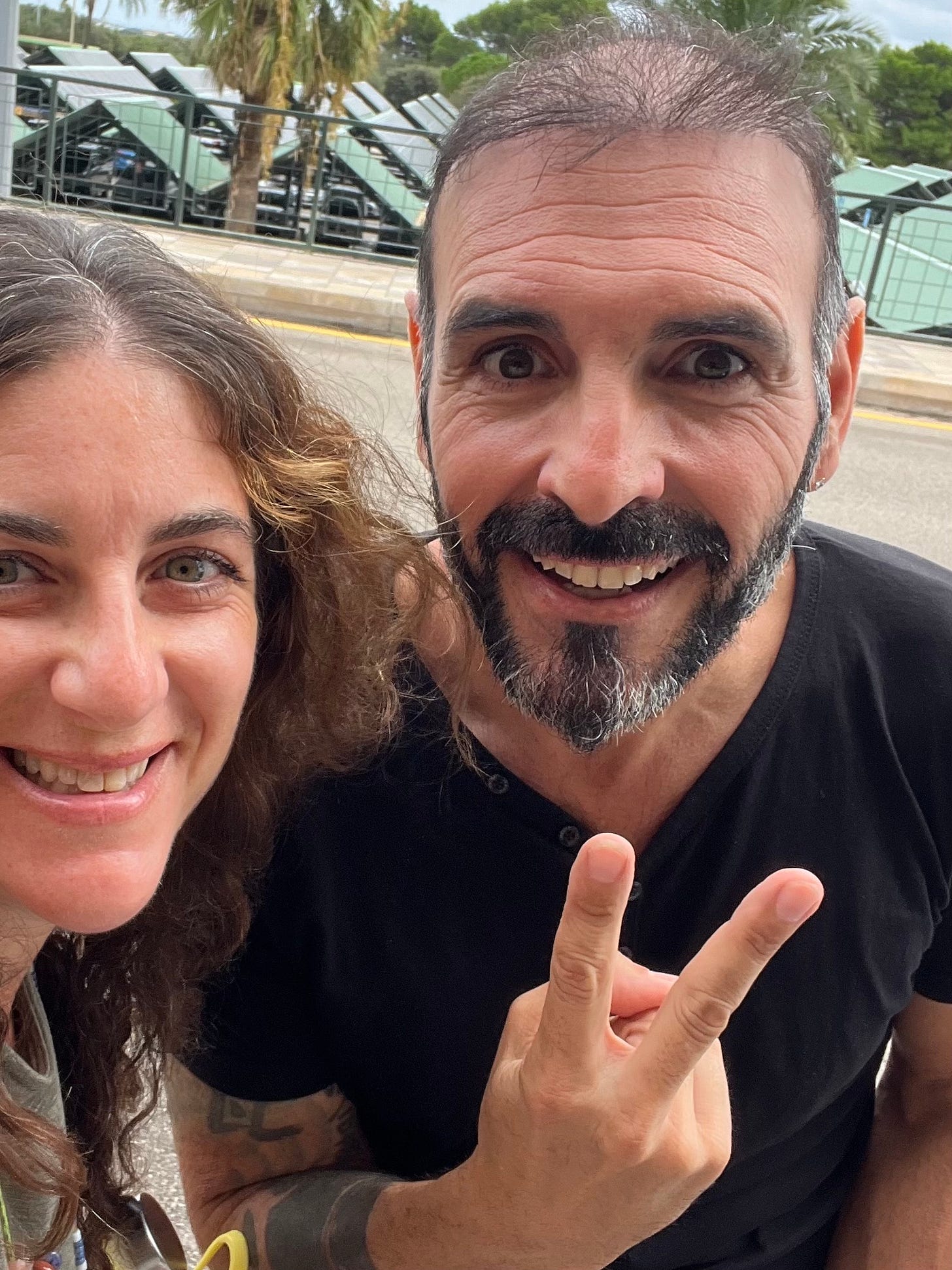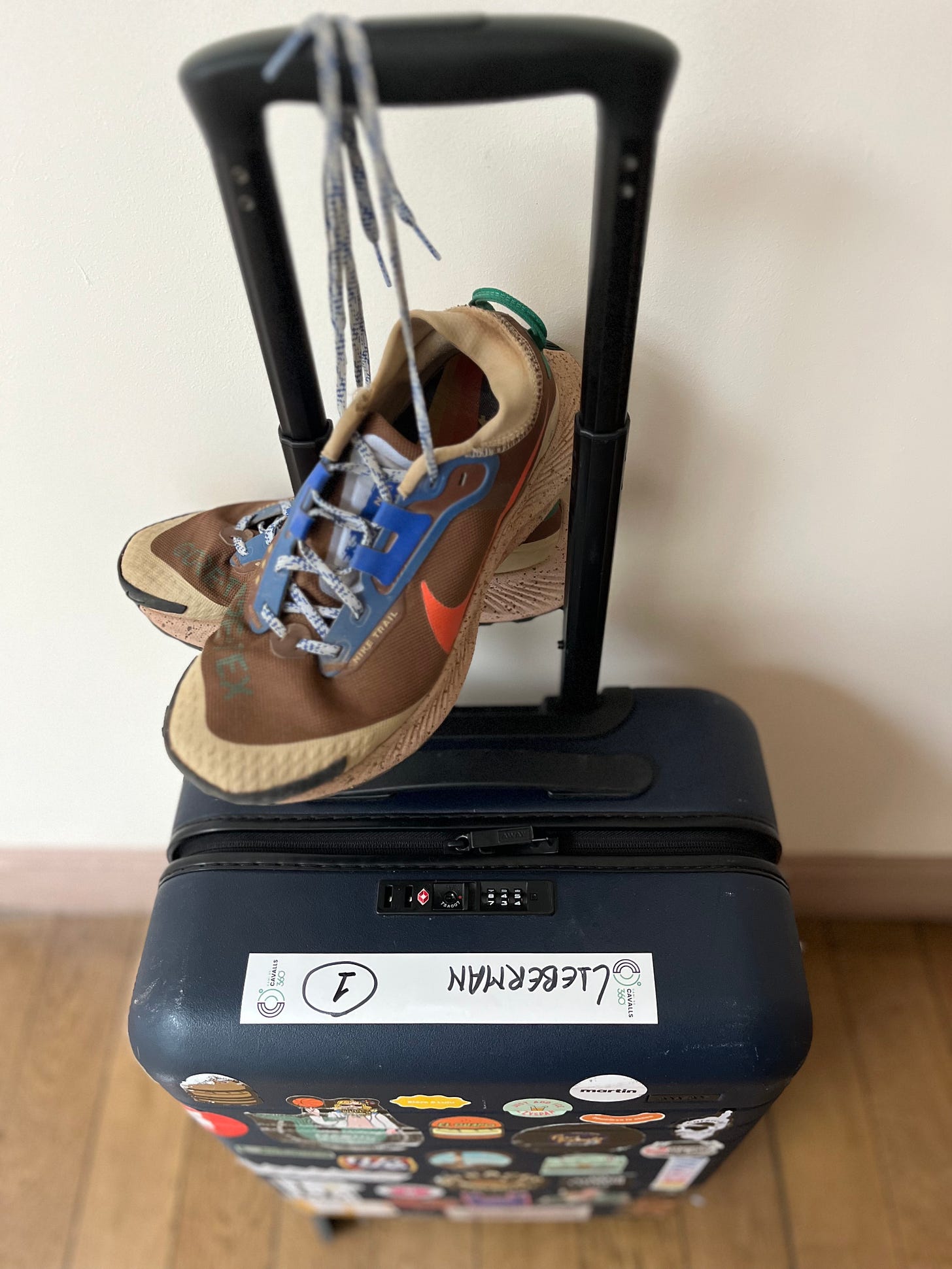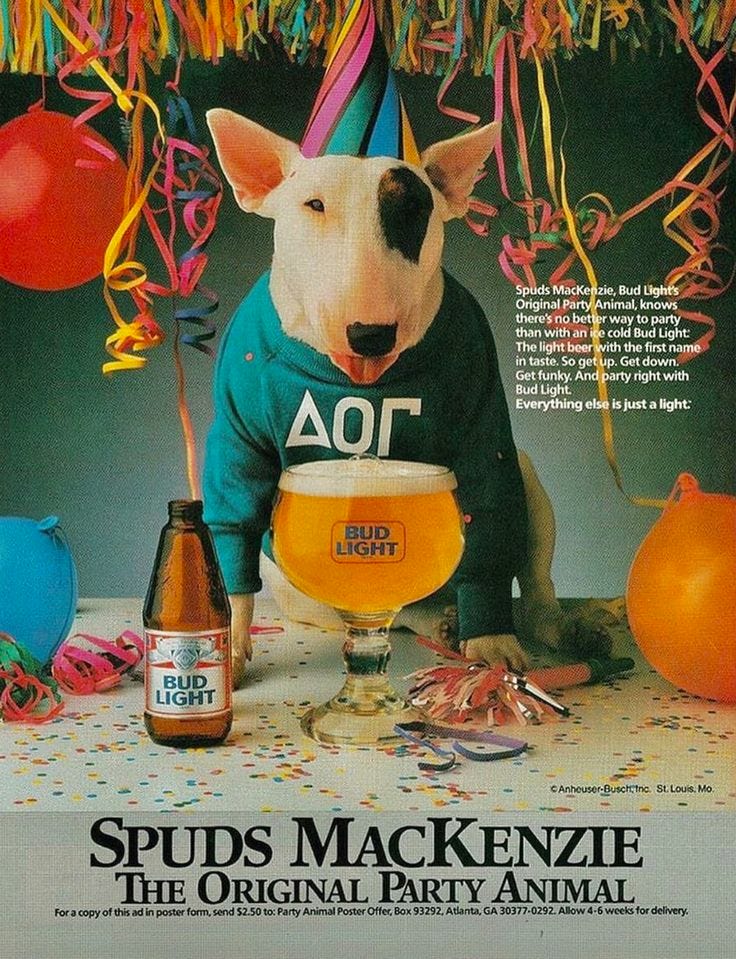An Unnamed Letter
Sneakers, labels, and bonding with strangers. Plus, Lenny Kravitz and Spuds MacKenzie.
My driver kept looking down at my feet, which were resting on the passenger side floor of his car. Dirty from days of hiking, I worried he was annoyed I’d just traipsed soil and muck all over his very clean sedan. It smelled of cherry air freshener and had some protection cushion on the dashboard. Jockeying my paranoia even further, he dodged an oncoming car as he continued to survey my feet and send me into an overthinking spiral.
Finally, he spoke up: “Your shoes…” he said. “They are Gortex. I have the same ones, but not Gortex. Those you only need for rain. Not much here in Menorca.”
Whew. He wasn’t mad about the dirt. Instead, we have the same shoes! Or similar ones!
These shoes actually make me feel like I’m in some sort of Cool Kids Adventure Club. My brother-in-law picked them out for me at a Nike outlet a couple of years ago. Despite them being men’s, and slightly a size too big, I got them anyway and have worn them on hikes in Israel, California, Corsica, Colorado, and France. With only two years under their belt, they’ve covered some ground! This wasn’t even the first time they’d received attention. Hikers have nodded toward them on the trail in approval before. Who knew how popular they were? Certainly pas moi. I’m an amateur when it comes to gear. The kind of amateur who doesn’t read instructions for how to use a hydration bladder before she embarks on a trek, and instead ends up watching a YouTube tutorial on the edge of a cliff because there’s a kink in the tube.
So there I was, in my Gortex trail runners on the way to the airport following seven days of hiking part of the island’s Camí de Cavalls, talking to my taxi driver who’s not mad about my dirty shoes. Buoyed by our newfound connection, I chime in:
“I just spent the week hiking a few stages of the Camí,” I say, eager to connect further after traveling solo for seven days. “It was mostly dry, but there was this one part on Stage 15 between Sant Tomas and Son Bou where I had to basically hop through a broken path in the muddy wetlands and the Gortex came in very handy.”
His English wasn’t great, so I didn’t think he caught the majority of what I said. But then: “Me, I won the Camí. 10 years ago. The race. I won!”
I’d heard about the races on the Camí de Cavalls, held for devout athletes who like some scenery with their competitive workout, and now a past winner was driving me to the airport after leisurely hiking some 35 of the 115-mile route. How ’bout that?
We spoke a bit more so that once we arrived, and after he lifted my luggage onto the curb and I paid for the ride, it seemed natural to suggest we take a selfie. He held up two fingers: Peace.
“Oh, and what’s your name?” I yelled back before he drove away.
Names come up a lot while traveling. There are passports and tickets, of course. But also check-ins and check-outs, restaurant and tour bookings, greetings, and introductions. My first name, while biblical, could be considered fairly innocuous in terms of faith. My last name, however, shouts pretty loudly that I am Jewish. But I grew up on New York’s Long Island where there were quite a few “mans,” “itzes,” “eins,” and “bergs” to keep me feeling at ease amongst the town’s otherwise mixed community. In Hebrew school and history class, I learned about the atrocities of the Holocaust, of course, and I had family who escaped the war. But I myself was fortunate enough not to experience any blatant anti-semitism. At 13, I attended a Bat or Bar Mitzvah almost every weekend. Once I moved to Manhattan, I went to the Matzah Ball and smoked a joint on the fire escape of a Lower East Side shul during Purim, and had the best bagels on every corner with smears in various flavors from scallion and lox to walnut raisin.
When I got to France, things were slightly different. I always say, being Jewish in France feels like a whisper. There are plenty of us, to be sure. But we’re quiet about it. Shhh, we don’t say. Here, seasonal pastries in local bakeries are named for Catholic holidays, most synagogues are hidden behind unsuspecting facades, and you rarely see anyone wearing a Star of David let alone a yarmulke unless you’re in the Marais and being chased down the street by a harmless Chabad member asking if you know how to put on Tefillin. Still, even if we can’t immediately spot or read one another, once it comes out there’s a sense of alliance. Like, “Oh, cool. Me too.” And then maybe: “Hey, do you know where can I get candles for Hanoucca?”
Over the course of my week in Menorca, as I stepped over dry, limestone cliffs overlooking turquoise coves, a war raged through Israel and Gaza. Hostages were being held, bodies were being buried, and innocent lives were being uprooted from the only homes they’d ever known. While I romped through lush green farmland, where cows and donkeys graze, and navigated over boardwalks hovering above windswept sand, anti-semitism spread rampantly. Sides were taken. Lines were drawn. It became difficult to make peace with the present moment, surrounded by such natural beauty, while knowing there was so much destruction and terror just across the Mediterranean past Tunisia and Sicily and Malta and Cyprus. Not to mention the misinformation and blame games spreading on social media. But I kept on and tried my best to be aware, to be grateful, to be joyful, and—as a Lieberman—to be careful.
As such, I started to consider what sharing my last name meant for my safety. Here I was, not in America or France, but on an island that belonged to a country that at one time in its history expelled a great lot of us. (Thanks for nothing, King Ferdinand and Queen Isabella.) So when people asked about its origin—and they almost always do for some reason; even though I suspect they already know the answer—I explained, trepidatiously: “I’m American Jewish. Nothing fancy.” As if downplaying it will change anything, or make either of us more comfortable.
Looks-wise I am often mistaken for Spanish or Italian—my complexion? my hair? my curves? I don’t know—so perhaps they’re just curious and confused more than anything. I rarely feel unsafe in these situations, just slightly awkward. Am I meant to inquire about their name and heritage? Do I push for more when I first meet a McGrath or an Abdallah or a Fernandez? Or, in the case of my driver, whose name I learned was Pati Banñls, a Banñls? Nah. Sure, I may wonder quietly to myself. But unless I’m reporting a story, and it’s crucial to the subject, I let it be. Shakespeare said it best: What’s in a name, anyway? In my experience—for us “mans,” “itzes,” “eins,” and “bergs”—a lot.
And so, this week, not only did I have to give and qualify my name with a hint of additional skepticism and, sadly, fear, but it was plastered onto my suitcase. Thankfully, it didn’t stand out too much as this particular piece of luggage is otherwise covered with stickers I’ve collected from my travels. But right there at the top was a long, white adhesive with my last name in capital letters, written in black sharpie: LIEBERMAN.
I didn’t want to take it off, but also: Shit, should I? The thing is, I really couldn’t! Its purpose was to aid a company that was transferring my luggage (and sometimes me) from one hotel to another as I hiked the route alone with only a day pack. They were dealing with dozens of bags and hikers all coming and going from different directions at various times. So I left it on. Always the rule follower, never one to ruffle feathers.
I suppose, as soon as I finished my hike, and certainly when I returned to France, I could’ve taken it off. But I didn’t. I haven’t. It’s not the same as my other stickers, but it fits in. It belongs—just like me and my Gortex sneakers that bond me with other trekkers. I wonder if Pati Banñls saw the sticker when he hoisted my bag in and out of the trunk. I don’t think so, but I’d like to think that if he did, it didn’t faze him. He was more focused on the shoes that linked us in a shared appreciation for the trail.
Back in Paris, just yesterday, I sat on a bench outside a coffee shop. An older man sat down next to me, insisting I not “bouger” (move). Of course, I shifted over to make room and we got to chatting in Franglais. His name was Claude and he owned the shop across the street. He detected an accent, as they always do, and asked where I was from. I told him, and he told me he’s 77 and has a sister-in-law from Australia whose accent is “horrible,” but otherwise her French is perfect. We discussed travel, and how he’s a biker who likes to see countries that way, having recently rolled through Bulgaria and Romania.
“I go first by bike, and if I like it I bring my wife back,” he said.
I mentioned my hike in Menorca and then he got a phone call, so I stood to take my leave. Before I did, he hung up, said to stop in his store sometime, and asked me my last name.
Here it comes, I think.
“Lieberman,” I say. Full stop, nothing more.
“Ah,” he says. “We are the same.”
A fellow Jew. I knew it. My shoulders relax. Tensions release. There’s a brief pause, before he says, “Never in my lifetime did I think I’d ever see anything like what I’ve seen in Ukraine and in Israel.”
Neither of us had more words to offer. We wished each other well and turned in opposite directions.
We are all born with feet for shoes. We all are given names for identification. They come in different shapes and sizes, with tricky spellings and pronunciations. But on the surface, they’re ordinary. Mere nouns. It’s what we do with them—how we let them move, represent, and connect us—that matters most.
As this war continues to divide and decimate, I hope we can use our bodies and wear our names with pride and intelligence, allowing us to connect with each other more easefully on benevolent levels. To, as Sara Bareilles so beautifully wrote, “use how we move through the world to demonstrate how you wish the world to be.” To expose our humanity simply as drivers, passengers, friends, family, neighbors, strangers, Jews, Muslims, Israelis, and Palestinians who, in the end, all walk this earth in maybe not the same shoes, but similar ones.
Sending love and light to you all. Thanks, as always, for being here. xx — Sara
Clickable
What Taylor Swift teaches us about ourselves. | NYT Magazine
NY-turned-LA food influencer “Bubbly Baz” is a hoot. | The Cut
Madonna: “We may not understand her in the moment, but rarely is she wrong about what’s coming.” | The Atlantic
Online wars wreak havoc, too. |
“We are all temporary dwellers wherever we live.” | The NY Times
Jack Antonoff: the “sonic architect” of pop music. | The Drift
What it means to reply in today’s world. | Dirt
New buzzy spots to eat in Paris! | (Me for) The Infatuation
Watchable
I’ll give you a moment while you wipe the drool from your chin. OK. Better? Now we can discuss 59-year-old Lenny Kravitz GETTING NAKED in his new video for a song called “TK421.” (Does anyone want to clue me into its title? Was too faint from watching him sing to listen to the actual lyrics.) Damn, he looks good! Does he age? Does his daughter Zoe want to run for the Hollywood Hills screaming from embarrassment? HT to
for the much-needed distraction.Currently overthinking…
…how many Menorca photos are too many photos to share on IG…
Souvenir: Spuds MacKenzie
It’s football season, which makes me think of chicken wings, beer, and commercials. (What? I should be thinking of the sport? Meh.) Naturally, this led me to recall “Original Party Animal” Spuds MacKenzie who debuted in a Super Bowl Bud Light commercial in 1987. The fictional bull terrier’s tenure as a mascot only lasted two years due to lots of controversies, which included a female dog playing a male dog, and his appeal to young children. Womp, woof.








Thank you for your words. and for that Lenny Kravitz video.
Was never one for bumper stickers. Though i do like to randomly chat with new people. we look for an opening and how it is received and if answered to an invite to carry on and get a glimpse of who you and or I, are. Good story of us humans being interested in real life. The inside thoughts of our minds. Thanks for sharing